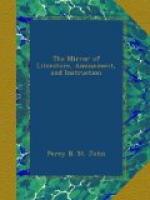“In a palace on the site of Hatton-garden, died John of Gaunt. Brook House, at the corner of the street of that name in Holborn, was the residence of the celebrated Sir Fulke Greville, Lord Brook, the ’friend of Sir Philip Sydney.’ In the same street, died, by a voluntary death, of poison, that extraordinary person, Thomas Chatterton—–
‘The sleepless boy, who perished
in his pride.’
Wordsworth.
He was buried in the workhouse in Shoe-lane; a circumstance, at which one can hardly help feeling a movement of indignation. Yet what could beadles and parish officers know about such a being? No more than Horace Walpole. In Gray’s Inn, lived, and in Gray’s Inn Garden meditated, Lord Bacon. In Southampton-row, Holborn, Cowper was a fellow-clerk to an attorney with the future Lord Chancellor Thurlow. At the Fleet-street corner of Chancery-lane, Cowley, we believe, was born. In Salisbury-court, Fleet-street, was the house of Thomas Sackville, first Earl of Dorset, the precursor of Spenser, and one of the authors of the first regular English tragedy. On the demolition of this house, part of the ground was occupied by the celebrated theatre built after the Restoration, at which Betterton performed, and of which Sir William Davenant was manager. Lastly, here was the house and printing-office of Richardson. In Bolt-court, not far distant, lived Dr. Johnson, who resided also for some time in the Temple. A list of his numerous other residences is to be found in Boswell[2]. Congreve died in Surrey-street, in the Strand, at his own house. At the corner of Beaufort-buildings, was Lilly’s, the perfumer, at whose house the Tatler was published. In Maiden-lane, Covent-garden, Voltaire lodged while in London, at the sign of the White Peruke. Tavistock-street was then, we believe, the Bond-street of the fashionable world; as Bow-street was before. The change of Bow-street from fashion to the police, with the theatre still in attendance, reminds one of the spirit of the Beggar’s Opera. Button’s Coffee-house, the resort of the wits of Queen’s Anne’s time, was in Russell-street—we believe, near where the Hummums now stand. We think we recollect reading also, that in the same street, at one of the corners of Bow-street, was the tavern where Dryden held regal possession of the arm chair. The whole of Covent-garden is classic ground, from its association with the dramatic and other wits of the times of Dryden and Pope. Butler lived, perhaps died, in Rose-street, and was buried in Covent-garden Churchyard; where Peter Pindar the other day followed him. In Leicester-square, on the site of Miss Linwood’s exhibition and other houses, was the town mansion of the Sydneys, Earls of Leicester, and the family of Sir Philip and Algernon Sydney. In the same square lived Sir Joshua Reynolds. Dryden lived and died in Gerrard-street, in a house which looked backwards into the garden of Leicester House. Newton lived in St. Martin’s-street,




